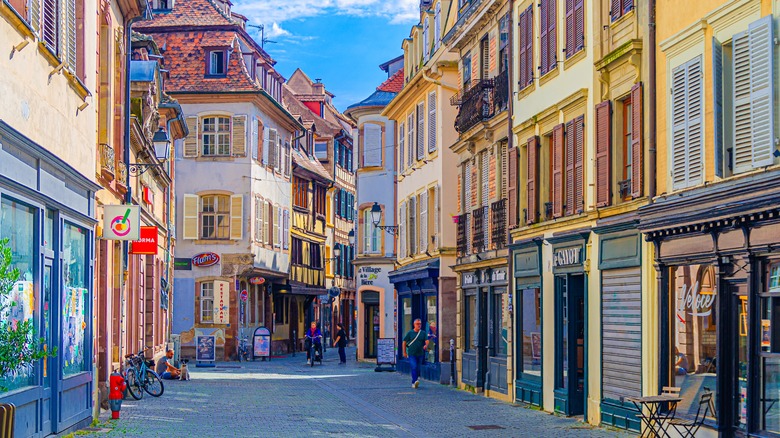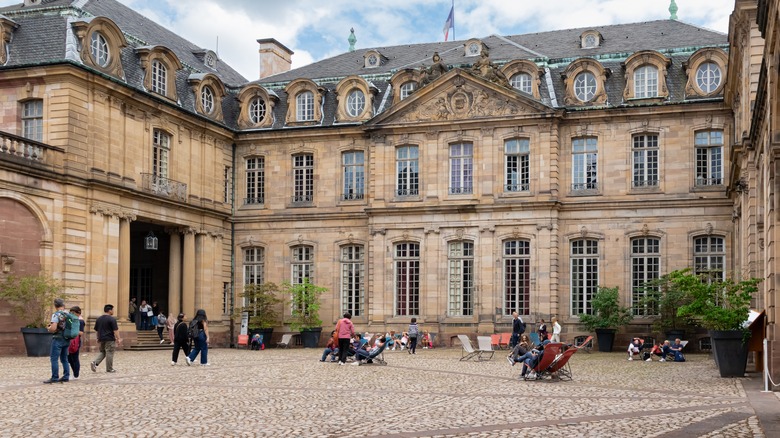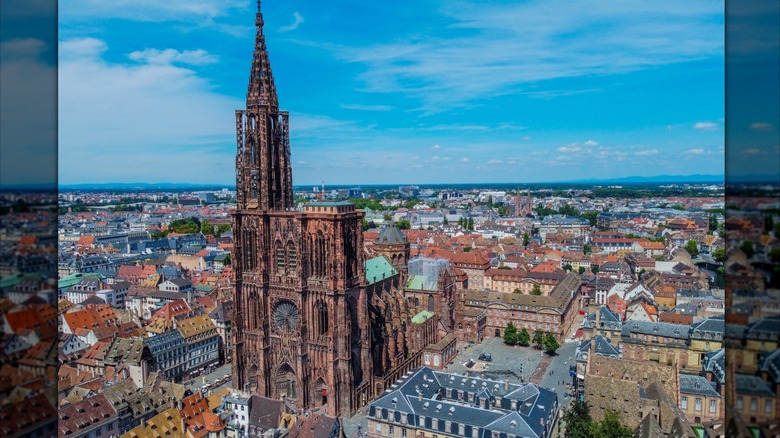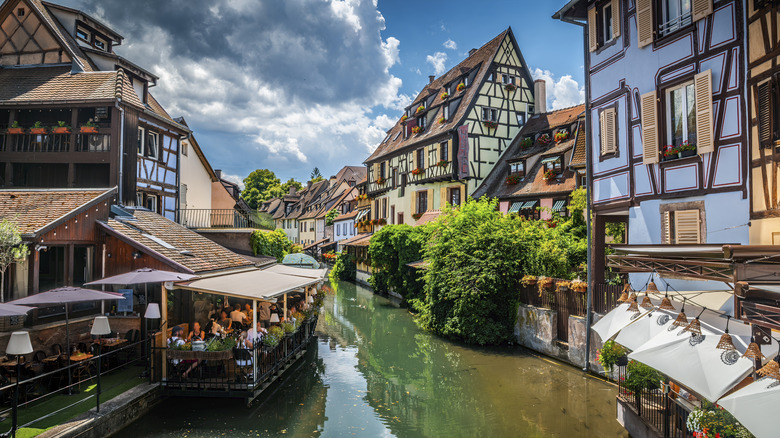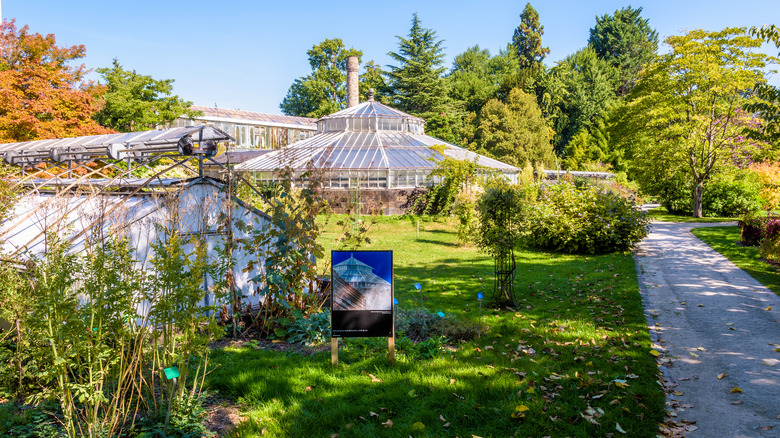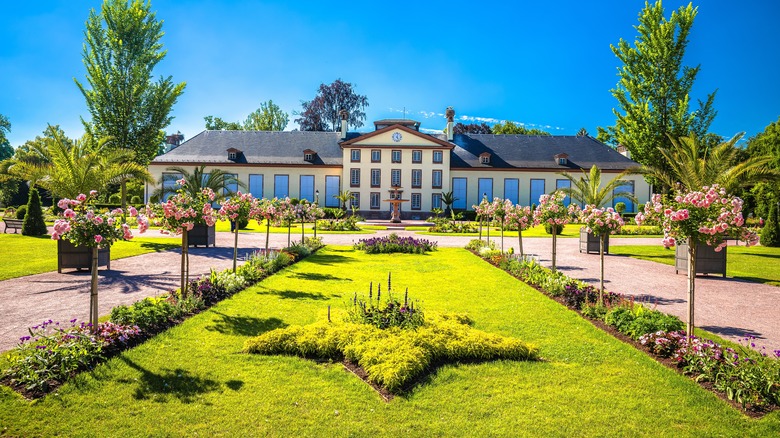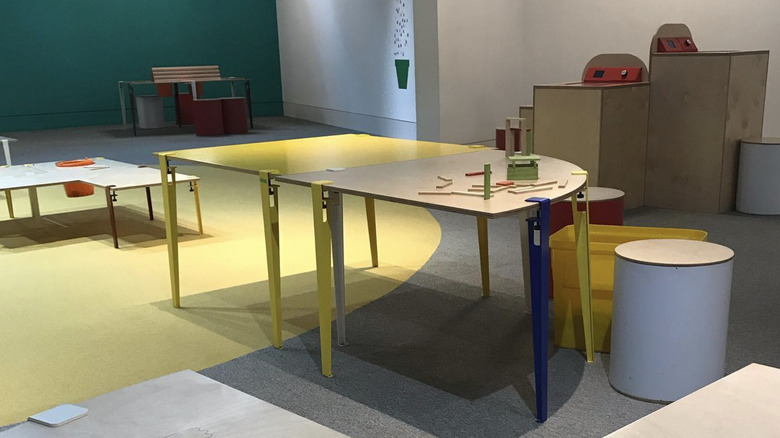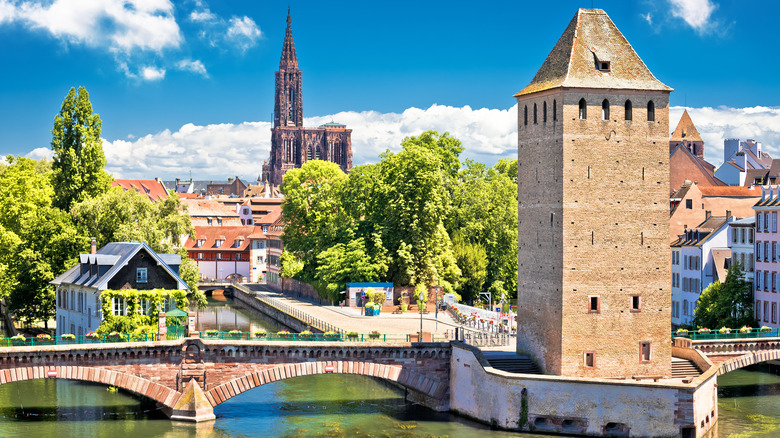Strasbourg, France's 9 Major Attractions And Destinations Worth Visiting
We may receive a commission on purchases made from links.
Strasbourg, France, is a city where many cultures meet. Formerly considered German territory, Strasbourg incorporates elements of different architectural styles — creating a city that blends French charm with German fairy tale magic. But, beyond its appeal for travelers trying to figure out how to choose between visiting France or Germany, Strasbourg stands as an important city in the modern political landscape. As one of the most important bases for the European Parliament, Strasbourg attracts residents and visitors of many different nationalities. The result is a rich multinational environment that welcomes people from all over the world.
Back in 2023, I had the pleasure of spending a week strolling Strasbourg's beautiful streets and engaging with its multicultural environment. In that time, I was able to dig deep into the city's fascinating history and explore its modern role as a European political powerhouse. Based on my travels — as well as feedback from other visitors and recommendations from local tourism boards — I was able to compile a list of the nine best attractions in Strasbourg. Using these tools, I aimed to create a list that did justice to Strasbourg's thriving historical center, incredible culinary scene, and spectacular outdoor spaces.
The three museums at Palais Rohan
Palais Rohan is a stunning French palace — but don't just take our word for it. Marie Antoinette resided there for the brief period preceding her 1770 nuptials, and Napoleon Bonaparte's wife, the Empress Josephine, stayed there during the days of the expanding empire. These days, travelers can roam Palais Rohan's corridors by visiting the trio of museums that lie behind its imposing walls.
The Decorative Arts Museum provides the best way to view the palace from the perspective of Marie Antoinette and Empress Josephine — allowing visitors to wander their old chambers. Gaze upon elaborate old canopy beds and step into a grand ballroom. With items dating back to 1681, this part of the palace will immerse you in the world of 17th-century luxury. The Fine Arts Museum, meanwhile, provides a more global artistic experience thanks to a collection featuring work by painters like El Greco, Goya, and Rubens. True history buffs should also check out the palace's Archaeological Museum, where they can observe Bronze Age tombs and Merovingian jewelry. Some items in the collection are more than 600,000 years old.
Palais Rohan is located just over a mile from the Strasbourg train station (Gare Centrale). If you choose to walk, grab a croissant at the L'Atelier 116 bakery along the way. At the time of writing, adult tickets to each of the museums cost €7.50 (around $9). Children can enter the Fine Arts and Decorative Arts museums for free, but must pay €3.50 ($4) at the Archaeological Museum.
The Cathédrale Notre-Dame de Strasbourg
Paris may be home to the reinvigorated Notre-Dame Cathedral, but Strasbourg has a Notre-Dame of its own. The Cathédrale Notre-Dame de Strasbourg — or "Our Lady of Strasbourg Cathedral" — is underrated yet absolutely worth a visit. Constructed between the 13th and 15th centuries, the cathedral represents one of the brightest architectural accomplishments of its era. With a spire stretching 465 feet into the air, it was also the world's tallest Christian building from the time of its completion in 1439 until the 19th century. The great French thinker, Victor Hugo, found inspiration in the structure, calling it, "a skillful combination of monumental size and delicateness."
To see the Cathédrale Notre-Dame de Strasbourg for yourself, head into the town's historic city center — approximately a 20-minute walk from the train station — and enter its magnificent threshold. Past visitors report that it's free to wander the pews and gaze upon the spectacular stained glass windows. However, for a price, visitors can climb the 330 steps up to the viewing platform located on the cathedral's roof and gaze down at Strasbourg's adorable old town. Currently, adults must pay €8 ($9.25) for this unique experience, while admission for children costs €5 ($5.75) each. Littles six and under enter for free. Free admittance is also available for those who require an accessible experience, so be sure to ask the appropriate authorities about your visiting options.
Walk or cruise along Strasbourg's canals
While Venice is known for its bridges and locks, there are plenty of other beautiful canal towns across the globe — and Strasbourg boasts some of the most picturesque canals in the world. Surrounded by traditional German-style houses, these scenic waterways snake through the historic city center, creating a uniquely tranquil ambiance. To get to know these beautiful sites, travelers are encouraged to walk along the pathways that line the canals. Be sure to walk along the Ponts Couverts — or "Covered Bridges" — which cross the canals in the shadow of a tower dating back to the 13th century. Also, don't forget to gaze upon the Barrage Vauban dam, which has been protecting Strasbourg from flooding since 1690.
Walking is not the only way to explore Strasbourg's canals. There are also a number of boat tours available for folks who would like to explore the waterways more directly. Every year from June to October, the Batorama boat company offers 45-minute rides from the historic city center to the Phare Citadelle's canal-side eatery. These one-way adventures allow travelers to view Strasbourg's historic architecture as they float down the river in style. Just keep in mind that to return to the center of Strasbourg, visitors must take a 20-minute taxi or a 25-minute bus. To access the canals, walk or taxi to the Pont Kuss bridge from the train station.
The University of Strasbourg Botanical Garden
Folks with a green thumb (and anyone on a budget) will love the University of Strasbourg Botanical Garden. Every year from March to December, this stunning public green space opens to the public free of charge — providing a beautiful environment to walk, sit, and otherwise enjoy a bit of fresh air. True plant lovers are sure to be impressed by the 5,500 plant varieties growing in the garden, while amateur historians will revel in the fact that the garden first opened back in 1619. Walking enthusiasts will also be pleased to know that the 8.6-acre park features a number of short trails — such as the remarkable trees or the endangered plants paths — that feature special examples of plant life.
Although visiting the University of Strasbourg Botanical Gardens is free, groups can get in touch with university authorities to schedule an hour-long guided tour of the premises starting from around €45 ($52). In previous years, free guided tours have been offered at 3 p.m. on the first Sunday of every month. Folks who are interested in this complimentary tour should reach out to the university for more information. The University of Strasbourg Botanical Gardens are located 1.7 miles from the Gare Centrale, and visitors can arrive via a peaceful stroll through the town's historic center.
Opéra National du Rhin
France is known for its incredible architecture and rich arts culture, but Strasbourg's impressive Opéra National du Rhin does not have its origins in the Land of Molière. Au contraire. When the opera house was built in 1898, Strasbourg was part of Germany. Since then, the structure has passed between French and German control several times — giving it a unique history. These days, the Opéra National du Rhin lends its stage to operas, ballets, and musicals from around the world. German operas, Russian ballets, and French performers all continue to take the stage. To enjoy the Opéra National du Rhin to the fullest, visitors are encouraged to check the schedule and attend a show.
Of course, there are other ways to appreciate this marvelous building. Available to book online, visitors can explore its interior on a 1.5-hour guided tour to view the 19th century architecture, gaze into the orchestra pit, and even wander backstage. Although the tours are exclusively available in French, English speakers may still enjoy the visual aspect of the experience. Alternatively, folks who would like to learn about the opera house's history in English can book a private walking tour of Strasbourg that's fully customized to their liking. Located a breezy 20-minute walk from the train station, the Opéra National du Rhin is easy to reach via the historic market street of Place Broglie.
Cave Historique des Hospices de Strasbourg
French wines are famous for their history, and Strasbourg's unique selection certainly proves it. To dive into the history of local winemaking, check out the Cave Historique des Hospices de Strasbourg. Once the town's hospital, the Hospices de Strasbourg lent its basements to wine storage for a whopping 600 years beginning in 1395. Back in the day, patients would pay for their treatment in the form of wine bottles and barrels — giving the Hospices de Strasbourg one of the top wine collections of its era. While times have certainly changed, the Hospices de Strasbourg continues to collect and age some of the region's best vintages, including Rieslings, Pinot Noirs, and Gewurztraminers. It is also home to centuries-old barrels.
A 15-minute drive from the Gare Centrale, visitors to the cellars can embark on a free self-guided tour, or opt for an English-language audio guide of the space for €3 ($3.50). Guided tours are also occasionally available upon request. To learn more, please contact the Cave Historique des Hospices de Strasbourg prior to your visit. Although wine tastings are only rarely available on specific open house days, there are plenty of nearby places to enjoy a glass of vin. This includes the A Cantina Comptoir Corse Strasbourg wine bar and the Royal 26 wine bar, both a quick walk away.
Parc de l'Orangerie
To get a local perspective on Strasbourg, head to the romantic gardens of the Parc de l'Orangerie. One of the top French hiking spots in the region, this park offers lush green grass, an artificial lake, and decorative fountains galore. Botany enthusiasts will enjoy wandering among the Orangerie's centuries-old trees, while animal lovers will adore the majestic white swans that reside on the premises. Stretch your legs as you stroll by the scenic man-made Charmille stream, and don't forget to peer into the Temple d'Amour — a romantic temple constructed in the 19th century. There may be no better place to relax in a stunning environment for free.
Interestingly, foodies will find some exciting eats in the park, as it is home to a 17th century farm-turned-restaurant called Le Buerehiesel. Here, you can sample plenty of local Alsatian flavors, ranging from braised veal to roasted lamb. Just keep in mind that Le Buerehiesel is a fine dining affair, with three-course menus starting at €55 ($64) per head. While this may seem pricey, Le Buerehiesel comes highly-recommended to those who crave a French fine dining experience.
To arrive at the Parc de l'Orangerie de Strasbourg, visitors can take a 25-minute bus or a 20-minute cab from the train station. Alternatively, they can also enjoy the 45-minute walk there — especially on a sunny day in the spring or summer.
Le Vaisseau Science Museum
Going on vacation with the whole family can mean a lot of extra organization, but by following one simple tip for traveling with kids, the whole experience can go much smoother. Rather than dragging little ones from one historic site to the next, parents can take them to destinations they actually want to see. And Strasbourg's Le Vaisseau Science Museum is definitely interesting enough to keep even the most active kids engaged.
At this hands-on museum, children have access to playhouses where they can test various scientific theories. They can also skip through The Factory — an area designed to teach little ones about artificial intelligence and computers. On sunny days in the spring and summer, kids can also prance around the Vaisseau's gardens, where they are allowed to dig, run, and otherwise enjoy the local flora.
At the time of writing, day passes to Le Vaisseau Science Museum cost €12 ($14) for both adults and children. Larger groups, however, can get a discount. To arrive at the Vaisseau Science Museum, take a 15-minute cab or a 20-minute bus from the train station. After your visit, walk five minutes to Parc de la Citadelle, where kids can enjoy a basic free water park in summer and playgrounds year-round.
Strasbourg's yearly Christmas market
Among all the European towns with Christmas markets you must visit, Strasbourg truly stands out. Known in France as the "Christmas capital," Strasbourg has been organizing some form of winter holiday market since the Middle Ages. Although the town's traditional Catholic market was barred in the 16th century during the era of the Protestant Reformation, it was too popular to banish completely — and local authorities quickly replaced it with a Protestant "Market of Baby Jesus." These days, the Strasbourg tradition of serving cheesy food and hot wine in December remains strong, with over 300 little chalet-style booths selling scrumptious eats like raclette, crepes, and pretzels covered in Emmental. Hand-made Christmas ornaments and decorations are also for sale, and crafty kids can find booths to make their own holiday cards.
To see the Strasbourg Christmas market for yourself, head into town sometime between the last week of November and Christmas Eve. Traditionally, the market only runs until December 24, so don't plan to go there on Christmas Day. Visitors can make their way to the nearby Place Broglie by car, bus, or foot. From there, it's about a 10-minute drive or bus ride to the market. As soon as they arrive, travelers can grab a hot drink, enjoy views of the town's 98-foot-tall Christmas tree, or even catch a Christmas concert.
Methodology
Compiling this list of the best destinations in Strasbourg combined the author's personal experiences with visitor feedback gathered from review platforms such as TripAdvisor, and local highlights found on official Strasbourg tourism websites. As a great budget-friendly destination for international visitors, the town has quite a bit to offer in terms of historic, culinary, and outdoor attractions. With this in mind, we sought to create a list that reflected a balance between these points.
Key landmarks like the Palais Rohan and the Cathédrale Notre-Dame de Strasbourg were chosen for their historical and architectural significance. Meanwhile, cultural and foodie destinatons such as the Opéra National du Rhin, Cave Historiques des Hospices, Le Buerehiesel, and the Christmas market highlight Strasbourg's rich heritage and flavors.
As for outdoor spaces, the Parc de l'Orangerie, the Strasbourg canals, and the University of Strasbourg Botanical Garden all reflect the city's natural charm. Finally, family-friendly spots, including the Vaisseau Science Museum, round out the list for visitors traveling with children.
